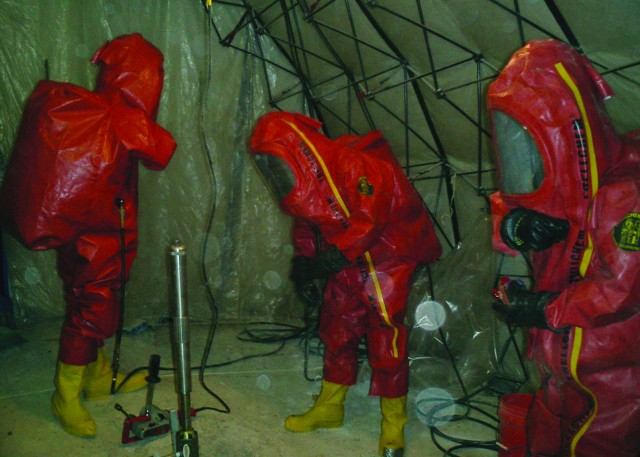If you didn't know it, the 20th Support Command Chemical Biological Radiological Nuclear and High-Yield Explosives Analytical Remediation Activity, also known as CARA-West resides here at Pine Bluff Arsenal. Formerly, known as the Army Technical Escort Unit, the team, made up of civilian chemical engineering technicians, has a varied and sometimes dangerous mission.
"We are part of FORSCOM (Army Forces Command). They own us," said Marvin Hubanks, chief of CARA-West. "In 2003, at the beginning of the Iraq war, what the Army realized albeit a little late is that they had a lot of organizations out there, but when it came down to deployment they weren't ready. This was the original concept for the Guardian Brigade units."
Hubanks said the intent of the Guardian Brigades was that the Army would go out and look for units with CBRNE skills. "The light bulb went on and they started looking at Tech Escort and EOD (Explosive Ordnance Disposal)," he said. "As it continued to evolve, the Army expanded their position on what they wanted this to be and do. It was then taken one step further because Tech Escort and EOD did not have the internal assets to deploy themselves. That is when they created the 20th Support Brigade, replacing the Guardian Brigade."
The vast majority of the Army's EOD was pulled into this brigade, said Hubanks. "They also pulled in a chemical brigade and the Tech Escort battalion," he said. "At that point they pulled the civilians out and created CARA. I think this was because of the continuity of the civilians who are there year after year through the transition of the Soldiers."
He said that CARA-West has a multitude of skills including all the chemical biological support, however, a forensic laboratory has been stood up as part of CARA. "This lab works on DNA capabilities in dealing with improvised explosive devices," he said. "They have just expanded our arena into forensics. So, we can catch the bad guys. They always leave some kind of trace behind."
Some form of Tech Escort - Soldier and Civilian - has been here at PBA since the 1980s. "I have been here about 12 years now," said Hubanks. "We are kind of a strange group because we do a little of everything. The Soldiers do the actual 'tech escort' missions now because they are trained in the area of chemical avoidance. We get all the other jobs because we are trained to go into the hazard."
The unit, which is a tenant organization here at the Arsenal, has been on some varied and dangerous missions over the years. For example, in 2003, they were deployed for weapons of mass destruction elimination in Iraq; in 2006, they went to Taji, Iraq on a mission near one of Saddam Hussein's chemical schools to deal with approximately 2, 400 empty liquid-fill rockets; and in 2008, they deployed on a mission called "The Dragon's Egg" to Fallujah, Iraq to deal with a possible chemical situation involving a buried tank supposedly filled with mustard agent.
"That was a crazy one and a little scary at times," said Hubanks, explaining that they had to build a camp out in the middle of the desert to protect themselves. "It was a lot of hard work. There was a lot of risk involved in this mission, so much so that the risk assessment I prepared had to be signed by Gen. (David Howell) Petraeus (Commanding General of the Multi-National Force-Iraq at that time) had to sign. This one scared everyone."
Fourteen members of the 20th from PBA just returned from a three-week trip to Deseret Chemical Depot in Utah. Their work there consisted of pulling agent samples from local ton container stockpiles of GA or Tabun nerve agent and Lewisite blister agent.
These samples will help the contractor who runs the chemical demilitarization incinerator there the data they need to verify system design and predict possible furnace rate feeds, according to an article in Demil-Trib, a publication at the Tooele Chemical Agent Disposal Facility.
With all the civilians and contractors working for CARA-West right now, Hubanks said that they have about 44 people. Support from the Arsenal is critical at times when they deploy to.
"We need help from people here at PBA when we deploy because it is always a last minute thing. We appreciate that support and like it when they can work with us to get what we need done," he said. "We don't always have the luxury of knowing when we are going to go on a mission so we appreciate the help when we ask for it. Only the Department of the Army can task us. So, when we ask for assistance we are asking for DA not just ourselves."
Hubanks said that because of the diversity and continuity of experience of his team it make them more capable of handling the variety of missions.
"These guys and gals work very hard at what they do," he said. "We are not completely green (Soldiers) and not completely civilian. We are a catch all. Whenever they don't know who to send, they send us."




Social Sharing